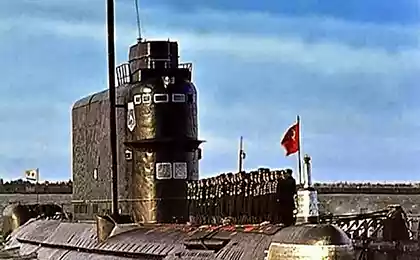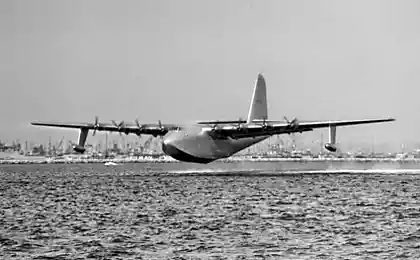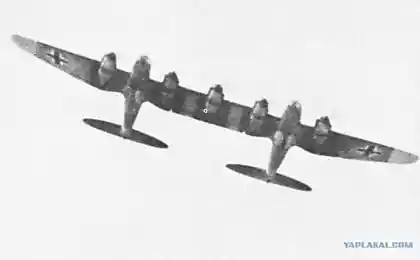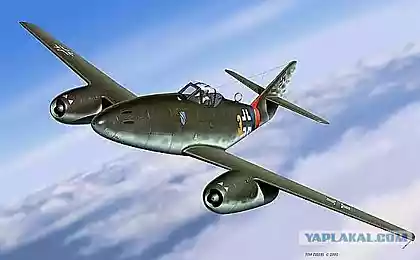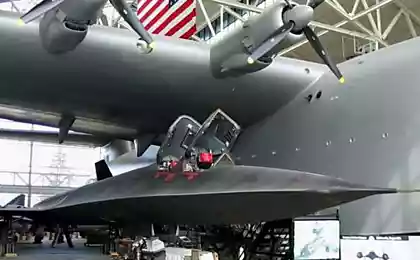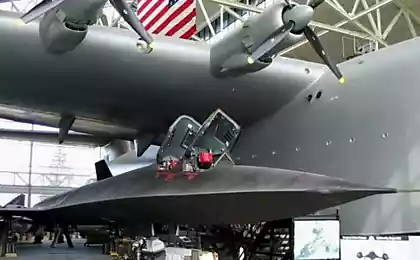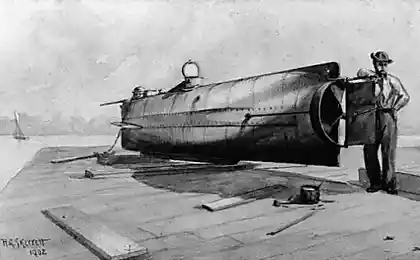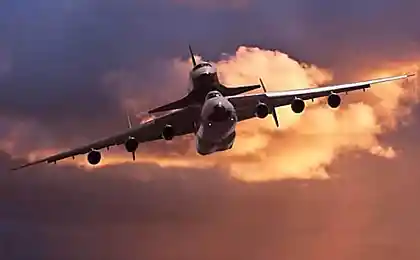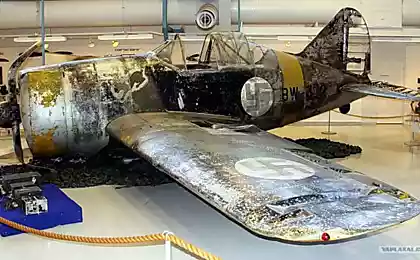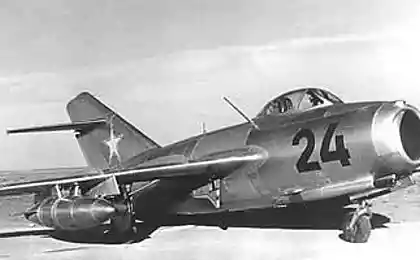20739
Is the huge wooden flying boat (36 pics + 3 videos)
Information from Wikipedia:
Hughes H-4 Hercules (Eng. Hughes H-4 Hercules) - transport wooden flying boat, designed by the American company Hughes Aircraft under the direction of Howard Hughes. This 136-ton aircraft, originally designated as NK-1 and received unofficial nickname Spruce Goose (Amer. & Quot; Shyogol & quot ;, & quot; Dude & quot;), was the largest ever built flying boat, and its wingspan and still remains a record - 98 meters. It was designed to transport 750 soldiers in full gear.

At the beginning of World War II, the US government has allocated $ 13 million for Hughes to manufacture the prototype of a flying ship, but by the end of hostilities the aircraft was not ready, due to shortage of aluminum and stubbornness Hughes, who sought to create a flawless car. Plane Hercules, piloted by Howard Hughes, made his first and only flight Only 2 November 1947, when I got up in the air to a height of 21 meters and covered about two kilometers in a straight line over the harbor of Los Angeles. After long-term storage plane was sent to the museum in Long Beach, California. Currently a museum exhibit of Evergreen International Aviation in McMinnville, Oregon, which was transported in 1993. But let us first things first ...
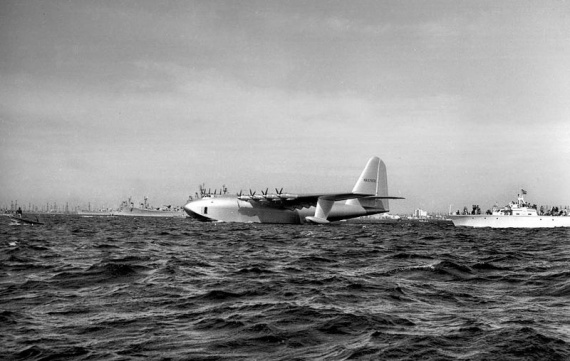
In the beginning of the war the Allies did not immediately realize what danger represent a German U-boat. WWI was safely forgotten, which resulted in a catastrophic losses in the Merchant Navy. If in 1939-1940. the number of ships sunk by the Germans did not go beyond the acceptable standards of losses, then in 1941-1942. Krigsmarine made a real terror in the Atlantic. The situation was stabilized by the end of 1942, and that, by increasing the global fleets cover. Nevertheless, the threat from submarines has not been eliminated. In such a situation was found quite predictable option - loads can throw not only water but also by air. Main problem was the fact that none of the parties at the time did not have the aircraft with sufficient carrying capacity.
The author of the original intent of this project was the Henry J.. Kaiser Steel Industrial magnate, owner of the shipyards, which produced during the Second World War ships of the series "Liberty." Designed and built aircraft company «Hughes Aircraft»: billionaire Howard Hughes and his team.
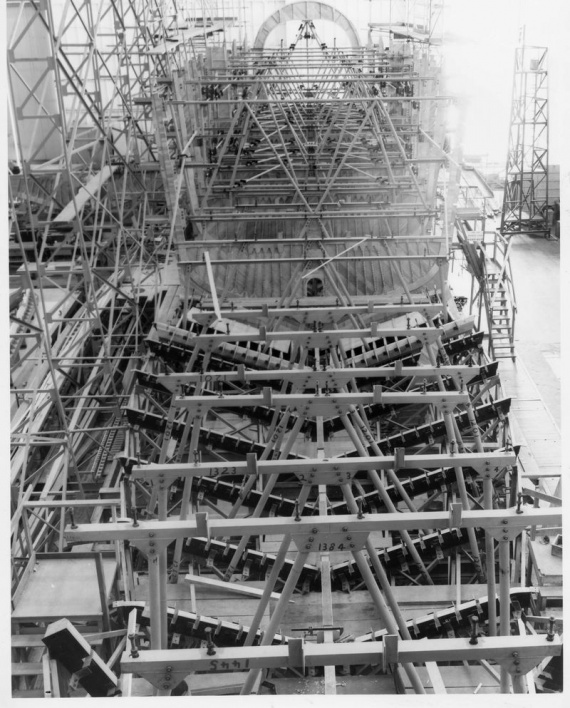
Order to build a multi-ton wooden amphibious aircraft with a wingspan of nearly one hundred meters was obtained from the US government in 1942. Was declared goal: to build a ship for passenger transportation so that spend the least possible number of strategic raw materials. That is: to make the plane had not made of metal and wood. The aircraft was designed to transport cargo and troops to help the warring Europe: a traditional waterway in a certain period of warfare was unavailable due to a strong development in the part of the enemy submarines.
Working documentation was developed quickly enough can not be said about the pace of construction of the aircraft. Begun in 1943, construction was completed in mid-1947 It was affected by a number of reasons ranging from the end of the war (and as a consequence - a lack of interest in further work on the NK-1 by the military) to the various legal proceedings against Hughes.
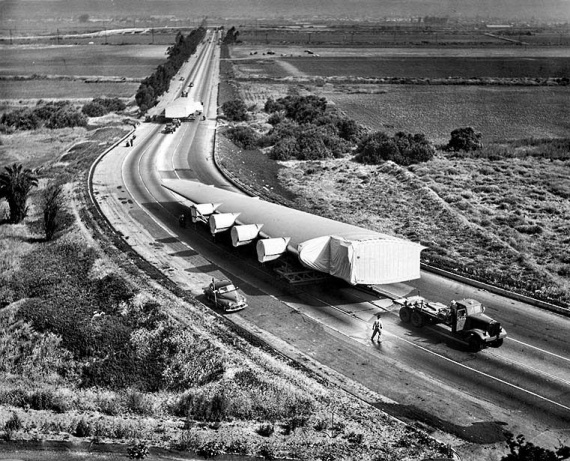
Throughout the project there were disputes about the extent of its funding, and a clear opinion about the necessity of such a project in principle and has not developed. One disgruntled US senators called the project a future aircraft "flying lumberyard." However, his most famous nickname - "Spruce Goose».
The official name of the aircraft was originally HK-1 (derived from the names of Hughes and Kaiser). After Kaiser abandoned the project in 1944, renamed the plane in Hughes H-4, and after the first flight changed the board room with NX37602 to N37602.
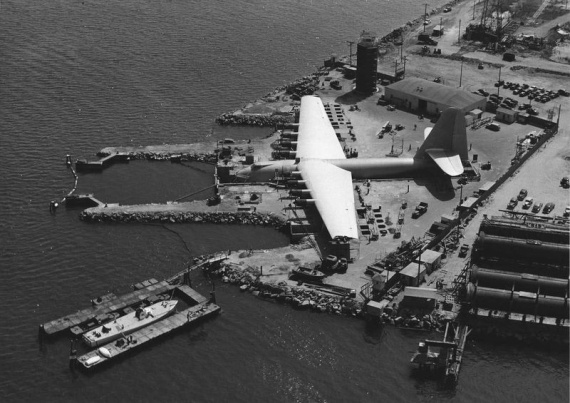
This huge flying boat consists of a body, cantilever wing and eight radial engines (motors brand Pratt & Whitney, 3000 hp each). And has a vertical tail unit, fixed wing floats. The whole structure consists of laminated wood (although the nickname is not used in the construction of spruce, birch and).
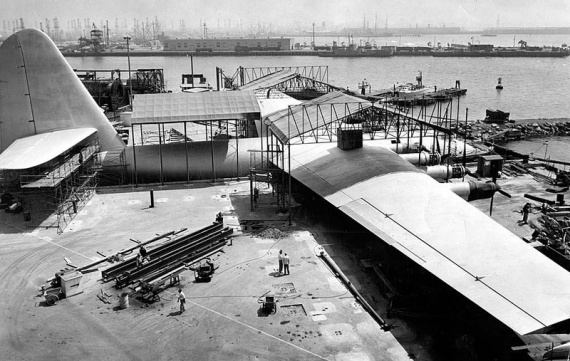
The physical parameters of amphibian were as follows:
length - more than 66 meters
height - 24 meters
wingspan - 98 meters
weight - 136 tons
the maximum weight of cargo - 59 tons
the maximum number of passengers - 700

Flight characteristics (presumably):
top speed - 378 km / h
cruising speed - 282 km / h
flight range - 5634 km
altitude - 7165 m

For all its unprecedented scale, to manage the aircraft crew needed just 3 people. Airframe was divided into two compartments: the flight deck to accommodate people and a large cargo area. For communication between compartments installed spiral staircases. Lower cargo compartment located fuel tanks, separated by watertight bulkheads.
Hughes Flying Boat and Kaiser was to be the largest ever built aircraft (actually, it was seven times greater than any aircraft built before him) and became the most awesome aviaproektom all time. Bring the building up to the end of the allowed only the courage and dedication of Howard Hughes and his small team of like-minded people, no matter what do not give up work and still send a "Hercules" in his historic flight only.
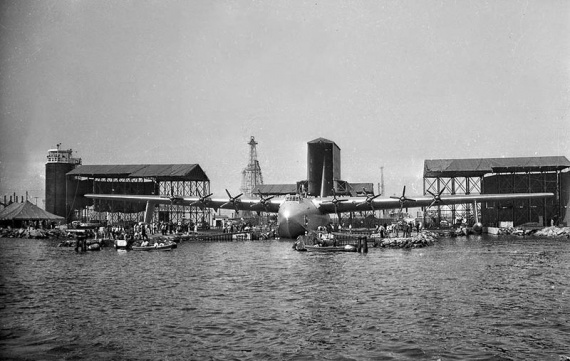
At some point, rigidly designated contradictions between the leaders of the project, Hughes and Kaiser Henry Kaiser proposes to limit the 70-ton machine in order to meet the deadline and provide the customer with the finished product; However, Hughes insisted on more - 200-ton aircraft, which demanded large investments of time and money. Henry Kaiser refused further participation in the project, and the Howard Hughes increasingly fond of the idea, making new proposals and improvements that further delayed the completion of construction.
In 1942, the US government was urgent priority order. By 1944, priorities have changed: because of the changing situation on the global front, the state's interest in the project disappeared. Government planned to cancel the contract for the construction. But the motivation Hughes had already ceased to be rational: rather, it was engulfed in the idea to build an air freighter, surpassing the boldest human imagination.

Hold the minds of the entire global project, Hughes did not lose sight of the most subtle details: nothing but his personal eccentricities, it was impossible to explain the need to spend hours discussing the design of the dashboard. Being a perfectionist by nature, he could not decide to recognize the work perfect, until so many delays have not attracted the attention of the Senate: committee was set up to verify the current works.
Construction of the aircraft was completed only in 1947: the United States from the state budget for the project has left a huge sum of 22 million dollars. But this was not all: because of lack of funding, Howard Hughes spent on the project's own 18 million.
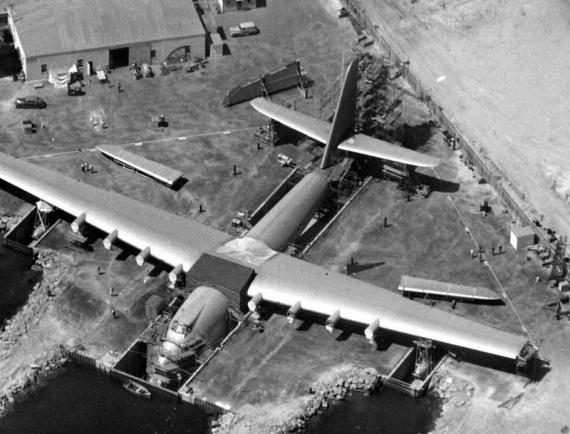
November 2, 1947 "Hercules" was launched and Howard Hughes and his small crew to start the engine in a test mode. Having made several passes through the water in front of excited spectators, mostly journalists, watching the movements of the ship, "Hercules" pulled away from the surface of the harbor of Los Angeles, went to his first and last, unannounced flight. Sam Hughes was at the helm.
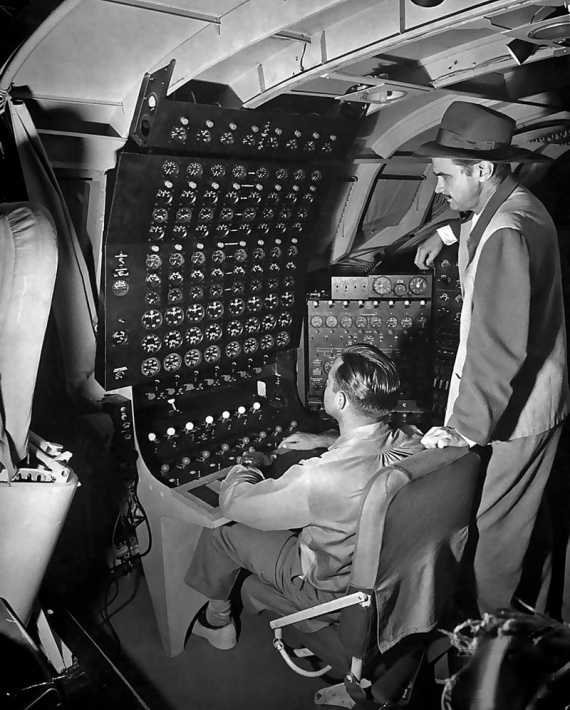
At low altitude, just over 20 meters, the plane was about two kilometers at a speed of 120 km / h and made a perfect landing. This trial run, the perfect Howard Hughes despite the official ban lifted "Hercules" in the air, was intended to rebuff critics of the project and to prove that the most extensive in the history of mankind aircraft still able to fly. Many still consider the flight one of the greatest moments in the history of aviation.
After completing his historic flight, "Spruce Goose" returned to his hangar - a huge, specially constructed room for him - never to fly. At the request of Hughes until his death in 1976, the state of the aircraft is maintained in full "alert", including - held monthly starting the engine.
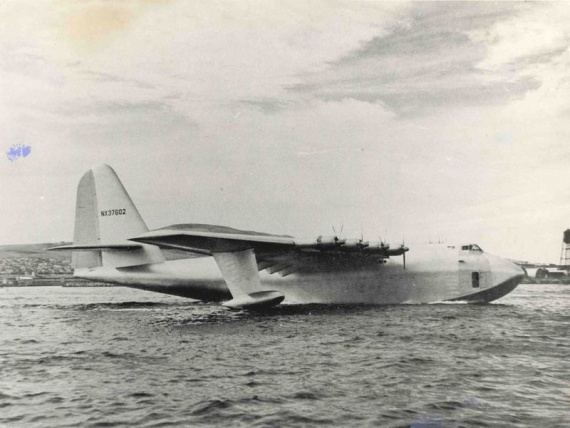
Over the past 50 years, the aircraft became one of America's favorite artifacts, going out of their actual uselessness of world military industry in the category of cultural objects. Today, its history is seen as an example of unparalleled determination and self-sacrifice. Hughes H-4 Hercules became one of the symbols of the twentieth century.
Though actually, "Hercules" Howard Hughes was not so useless. This aircraft, with all the imperfections, decades ahead of his time, was one of the steps of the technological revolution not only in aviation, but also in engineering in general. He demonstrated the potential of artificial aircraft, have largely shaped the modern understanding of the implementation of operations.
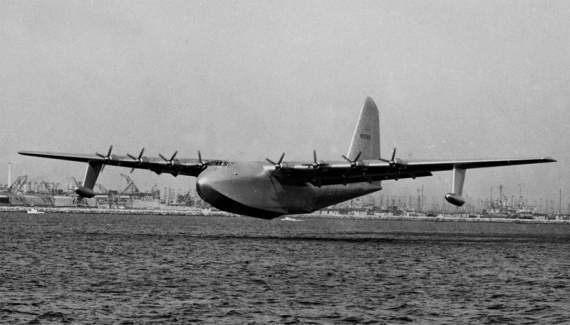
After long-term storage on the basis of aero club in Southern California, near the overage ocean liner «Queen Mary», in 1992, the aircraft was transferred to the Evergreen Aviation Museum - a museum and educational center in Oregon. To this day, it remains the largest of aircraft built by man, rises into the air.

Most interesting is that its prototype seen many of you. Of course, provided that you watched the movie "The Aviator," with Leonardo DiCaprio (Leonardo DiCaprio).
Creator «Hughes H-4 Hercules», named Howard Hughes (Howard Hughes), who led his own firm «Hughes Aircraft», became the prototype for the main character of the painting "The Aviator".
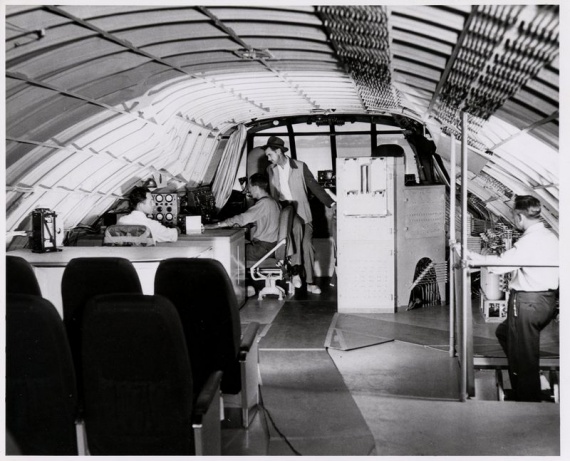
In the world there are planes longer have load-carrying capacity, but first flew in 1947, & quot; Hercules & quot; is still unbeaten in wingspan (97, 5 m) and height to the tip of the keel was able to catch up with him only the latest A-380-800.



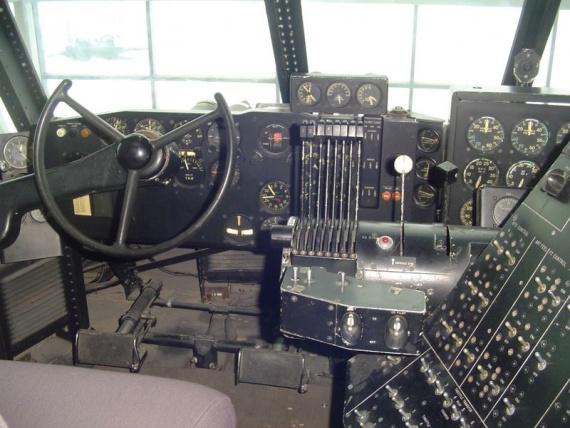

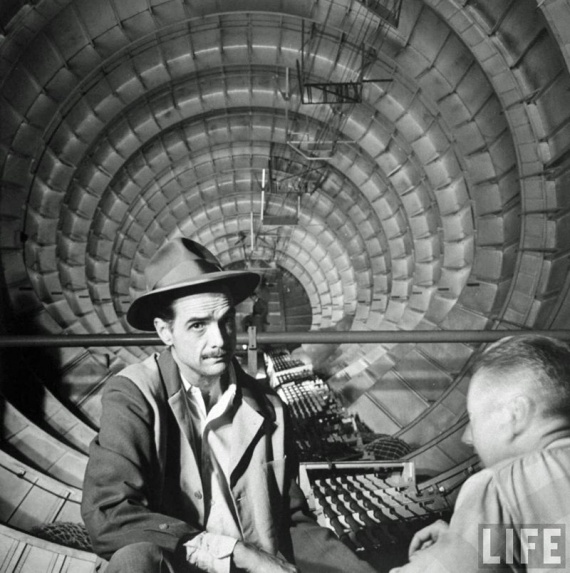
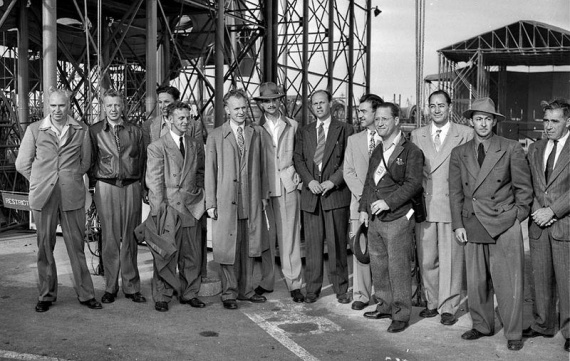
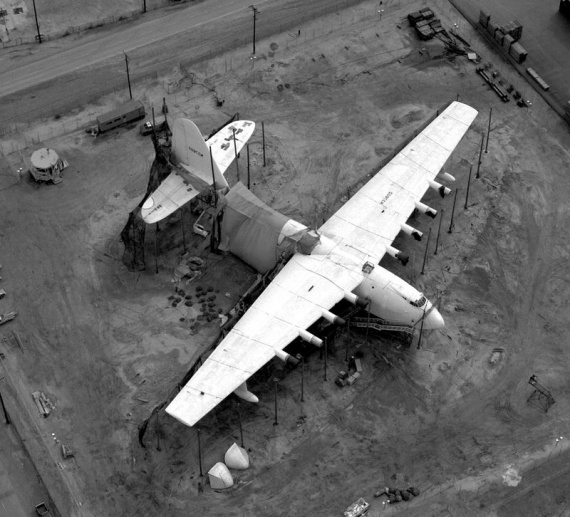

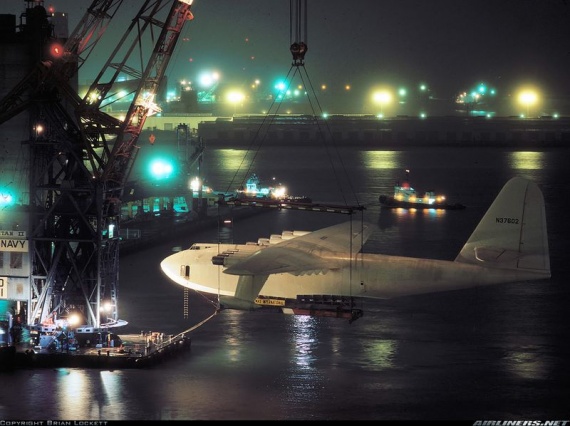
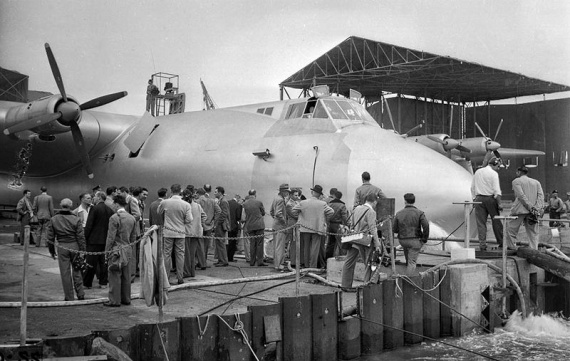
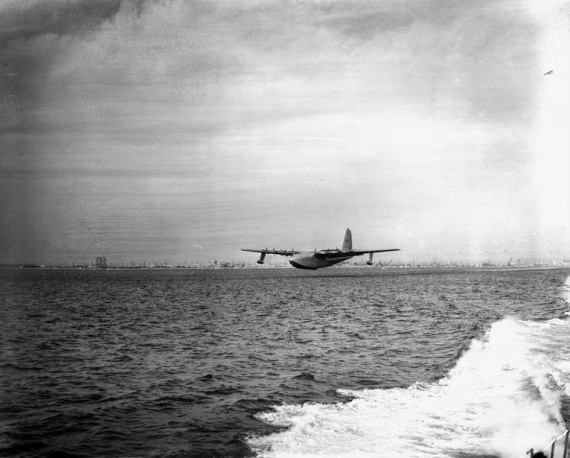
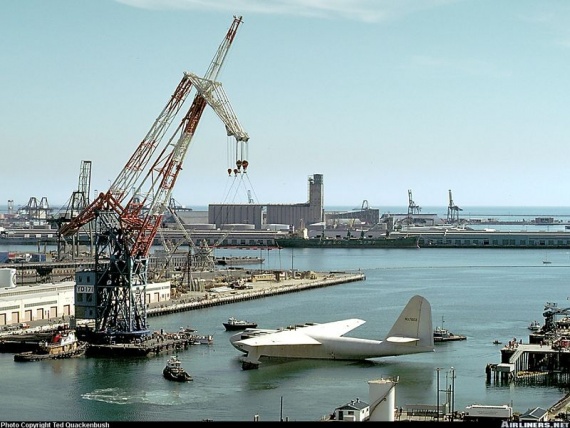

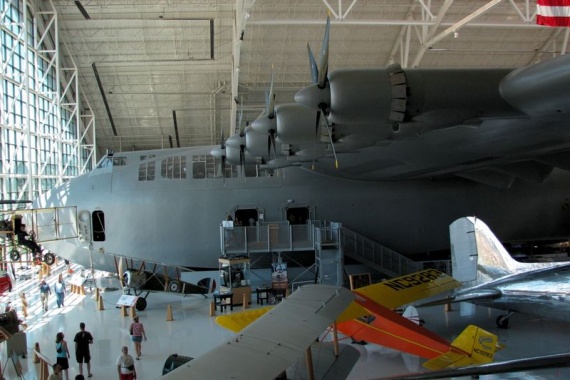
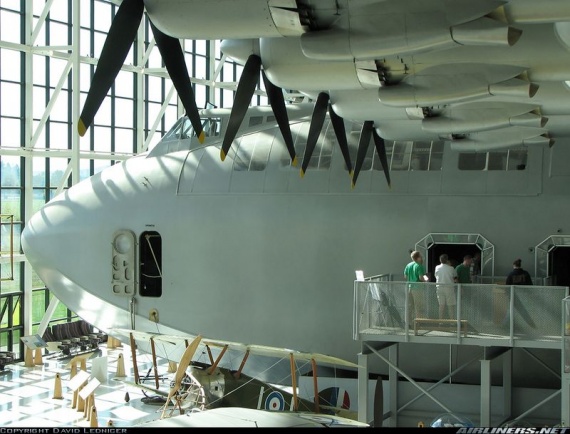
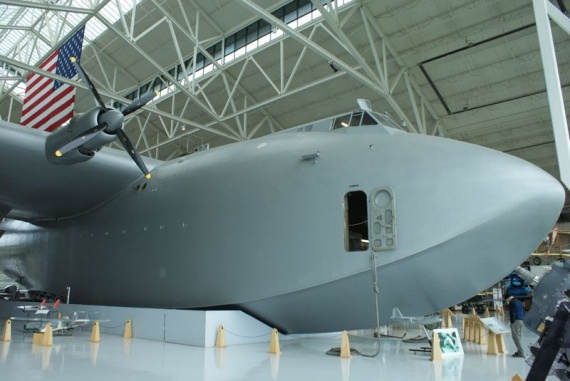

Source: masterok.livejournal.com
Hughes H-4 Hercules (Eng. Hughes H-4 Hercules) - transport wooden flying boat, designed by the American company Hughes Aircraft under the direction of Howard Hughes. This 136-ton aircraft, originally designated as NK-1 and received unofficial nickname Spruce Goose (Amer. & Quot; Shyogol & quot ;, & quot; Dude & quot;), was the largest ever built flying boat, and its wingspan and still remains a record - 98 meters. It was designed to transport 750 soldiers in full gear.

At the beginning of World War II, the US government has allocated $ 13 million for Hughes to manufacture the prototype of a flying ship, but by the end of hostilities the aircraft was not ready, due to shortage of aluminum and stubbornness Hughes, who sought to create a flawless car. Plane Hercules, piloted by Howard Hughes, made his first and only flight Only 2 November 1947, when I got up in the air to a height of 21 meters and covered about two kilometers in a straight line over the harbor of Los Angeles. After long-term storage plane was sent to the museum in Long Beach, California. Currently a museum exhibit of Evergreen International Aviation in McMinnville, Oregon, which was transported in 1993. But let us first things first ...

In the beginning of the war the Allies did not immediately realize what danger represent a German U-boat. WWI was safely forgotten, which resulted in a catastrophic losses in the Merchant Navy. If in 1939-1940. the number of ships sunk by the Germans did not go beyond the acceptable standards of losses, then in 1941-1942. Krigsmarine made a real terror in the Atlantic. The situation was stabilized by the end of 1942, and that, by increasing the global fleets cover. Nevertheless, the threat from submarines has not been eliminated. In such a situation was found quite predictable option - loads can throw not only water but also by air. Main problem was the fact that none of the parties at the time did not have the aircraft with sufficient carrying capacity.
The author of the original intent of this project was the Henry J.. Kaiser Steel Industrial magnate, owner of the shipyards, which produced during the Second World War ships of the series "Liberty." Designed and built aircraft company «Hughes Aircraft»: billionaire Howard Hughes and his team.

Order to build a multi-ton wooden amphibious aircraft with a wingspan of nearly one hundred meters was obtained from the US government in 1942. Was declared goal: to build a ship for passenger transportation so that spend the least possible number of strategic raw materials. That is: to make the plane had not made of metal and wood. The aircraft was designed to transport cargo and troops to help the warring Europe: a traditional waterway in a certain period of warfare was unavailable due to a strong development in the part of the enemy submarines.
Working documentation was developed quickly enough can not be said about the pace of construction of the aircraft. Begun in 1943, construction was completed in mid-1947 It was affected by a number of reasons ranging from the end of the war (and as a consequence - a lack of interest in further work on the NK-1 by the military) to the various legal proceedings against Hughes.

Throughout the project there were disputes about the extent of its funding, and a clear opinion about the necessity of such a project in principle and has not developed. One disgruntled US senators called the project a future aircraft "flying lumberyard." However, his most famous nickname - "Spruce Goose».
The official name of the aircraft was originally HK-1 (derived from the names of Hughes and Kaiser). After Kaiser abandoned the project in 1944, renamed the plane in Hughes H-4, and after the first flight changed the board room with NX37602 to N37602.

This huge flying boat consists of a body, cantilever wing and eight radial engines (motors brand Pratt & Whitney, 3000 hp each). And has a vertical tail unit, fixed wing floats. The whole structure consists of laminated wood (although the nickname is not used in the construction of spruce, birch and).

The physical parameters of amphibian were as follows:
length - more than 66 meters
height - 24 meters
wingspan - 98 meters
weight - 136 tons
the maximum weight of cargo - 59 tons
the maximum number of passengers - 700

Flight characteristics (presumably):
top speed - 378 km / h
cruising speed - 282 km / h
flight range - 5634 km
altitude - 7165 m

For all its unprecedented scale, to manage the aircraft crew needed just 3 people. Airframe was divided into two compartments: the flight deck to accommodate people and a large cargo area. For communication between compartments installed spiral staircases. Lower cargo compartment located fuel tanks, separated by watertight bulkheads.
Hughes Flying Boat and Kaiser was to be the largest ever built aircraft (actually, it was seven times greater than any aircraft built before him) and became the most awesome aviaproektom all time. Bring the building up to the end of the allowed only the courage and dedication of Howard Hughes and his small team of like-minded people, no matter what do not give up work and still send a "Hercules" in his historic flight only.

At some point, rigidly designated contradictions between the leaders of the project, Hughes and Kaiser Henry Kaiser proposes to limit the 70-ton machine in order to meet the deadline and provide the customer with the finished product; However, Hughes insisted on more - 200-ton aircraft, which demanded large investments of time and money. Henry Kaiser refused further participation in the project, and the Howard Hughes increasingly fond of the idea, making new proposals and improvements that further delayed the completion of construction.
In 1942, the US government was urgent priority order. By 1944, priorities have changed: because of the changing situation on the global front, the state's interest in the project disappeared. Government planned to cancel the contract for the construction. But the motivation Hughes had already ceased to be rational: rather, it was engulfed in the idea to build an air freighter, surpassing the boldest human imagination.

Hold the minds of the entire global project, Hughes did not lose sight of the most subtle details: nothing but his personal eccentricities, it was impossible to explain the need to spend hours discussing the design of the dashboard. Being a perfectionist by nature, he could not decide to recognize the work perfect, until so many delays have not attracted the attention of the Senate: committee was set up to verify the current works.
Construction of the aircraft was completed only in 1947: the United States from the state budget for the project has left a huge sum of 22 million dollars. But this was not all: because of lack of funding, Howard Hughes spent on the project's own 18 million.

November 2, 1947 "Hercules" was launched and Howard Hughes and his small crew to start the engine in a test mode. Having made several passes through the water in front of excited spectators, mostly journalists, watching the movements of the ship, "Hercules" pulled away from the surface of the harbor of Los Angeles, went to his first and last, unannounced flight. Sam Hughes was at the helm.

At low altitude, just over 20 meters, the plane was about two kilometers at a speed of 120 km / h and made a perfect landing. This trial run, the perfect Howard Hughes despite the official ban lifted "Hercules" in the air, was intended to rebuff critics of the project and to prove that the most extensive in the history of mankind aircraft still able to fly. Many still consider the flight one of the greatest moments in the history of aviation.
After completing his historic flight, "Spruce Goose" returned to his hangar - a huge, specially constructed room for him - never to fly. At the request of Hughes until his death in 1976, the state of the aircraft is maintained in full "alert", including - held monthly starting the engine.

Over the past 50 years, the aircraft became one of America's favorite artifacts, going out of their actual uselessness of world military industry in the category of cultural objects. Today, its history is seen as an example of unparalleled determination and self-sacrifice. Hughes H-4 Hercules became one of the symbols of the twentieth century.
Though actually, "Hercules" Howard Hughes was not so useless. This aircraft, with all the imperfections, decades ahead of his time, was one of the steps of the technological revolution not only in aviation, but also in engineering in general. He demonstrated the potential of artificial aircraft, have largely shaped the modern understanding of the implementation of operations.

After long-term storage on the basis of aero club in Southern California, near the overage ocean liner «Queen Mary», in 1992, the aircraft was transferred to the Evergreen Aviation Museum - a museum and educational center in Oregon. To this day, it remains the largest of aircraft built by man, rises into the air.

Most interesting is that its prototype seen many of you. Of course, provided that you watched the movie "The Aviator," with Leonardo DiCaprio (Leonardo DiCaprio).
Creator «Hughes H-4 Hercules», named Howard Hughes (Howard Hughes), who led his own firm «Hughes Aircraft», became the prototype for the main character of the painting "The Aviator".

In the world there are planes longer have load-carrying capacity, but first flew in 1947, & quot; Hercules & quot; is still unbeaten in wingspan (97, 5 m) and height to the tip of the keel was able to catch up with him only the latest A-380-800.


















Source: masterok.livejournal.com




